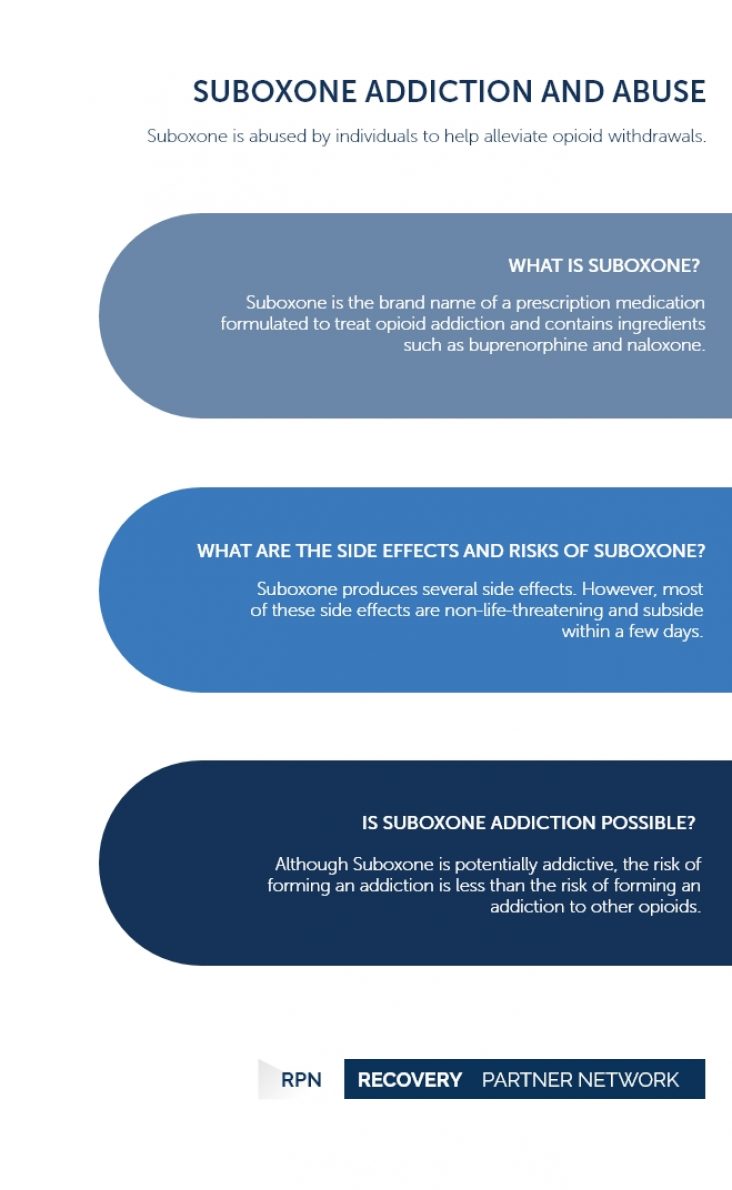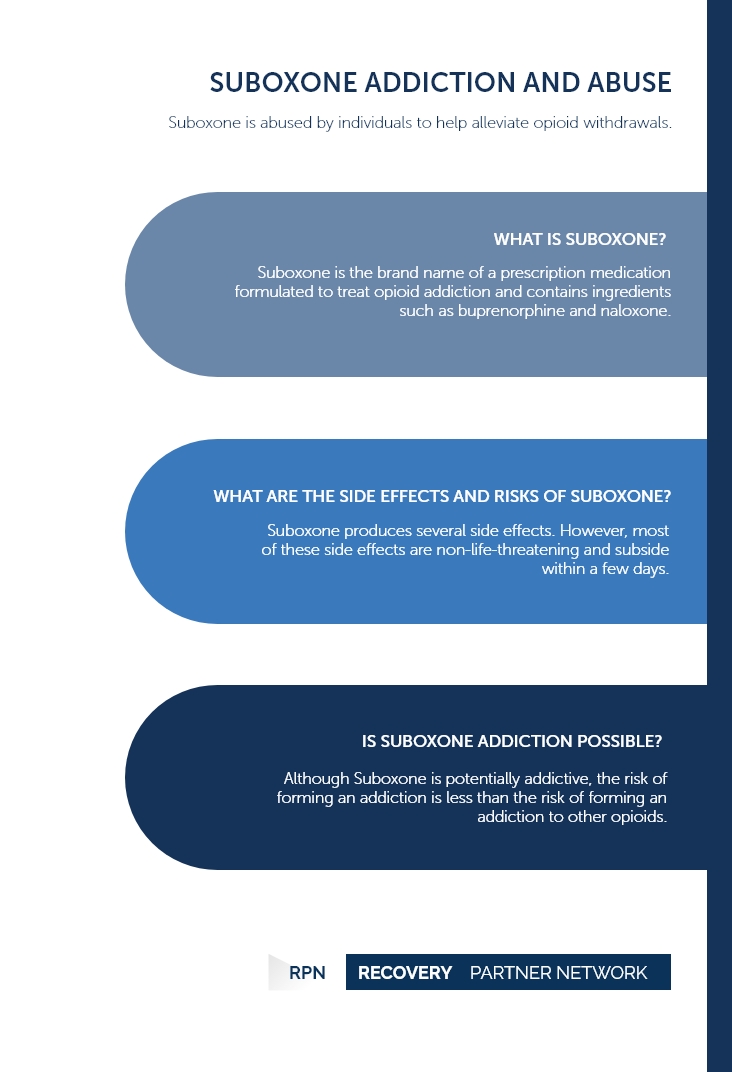Suboxone is abused by individuals to help alleviate opioid withdrawals.
Suboxone Addiction and Abuse
Opioid
- Hydrocodone/paracetamol addiction
- Buprenorphine/Naloxone addiction
- Central nervous system depressant
- Codeine addiction
- Dextropropoxyphene addiction
- Fentanyl abuse
- Hydromorphone addiction
- How Long do Opioids Stay in Your System?
- Hydrocodone addiction
- Kava addiction and abuse
- Loperamide addiction
- Lortab addiction
- Medical prescription opioid
- Methadone addiction
- Morphine addiction
- Norco addiction
- NyQuil addiction
- Opioid use disorder
- OTC substance abuse
- Oxycodone addiction
- Oxycodone/paracetamol addiction
- Opioid epidemic
- Lean addiction
- Pethidine addiction
- Snorting Oxycodone
- Synthetic Opioids
- Tramadol addiction
Buprenorphine/Naloxone addiction | Table of Contents
What is Suboxone?
Suboxone is the brand name of a prescription medication that is formulated to treat opioid addiction. Suboxone contains buprenorphine and naloxone, both of which are combined to reduce the urge for addictive drugs such as heroin, codeine, fentanyl, and oxycodone. It is typically taken by individuals undergoing opioid addiction treatment to regulate withdrawal during detox. Individuals may also continue to take Suboxone after detox to manage cravings and withdrawal while undergoing therapy and rehab. Suboxone is not intended as a cure for opioid abuse. It is instead a helpful component of the recovery process.
Suboxone is classified as a Schedule III controlled substance in the US, as it provides therapeutic benefits while also containing a moderate risk for addiction. As such, it can only be prescribed by physicians licensed by the Department of Health and Human Services (HHS). Suboxone is available as dissolvable films and tablets.
Suboxone made several headlines as a game-changing drug that can turn the clock back on heroin addiction. With a revenue of over $1.55 billion, Suboxone sold more units than Viagra and Adderall in 2013, prompting The New York Times to rate it as a “blockbuster” product that was (and still is) a healthier alternative to methadone in the face of a major opioid addiction crisis.
FAQ
The U.S. Food and Drug Administration officially approved the first generic versions of Suboxone sublingual film for treating opioid dependence.
Suboxone sublingual is a non-coated hexagonal orange tablet, debossed with an alphanumeric word classifying the product and strength.
Depending on the pharmacy you purchase the medicine from, a Suboxone sublingual film with a dosage of 2 mg to 0.5 mg cost around $166 for a supply of 30 films.
Understanding the Two Ingredients of Suboxone
Buprenorphine and naloxone are the two main ingredients of Suboxone. Buprenorphine is an opioid that is more potent than morphine. The National Alliance of Advocates for Buprenorphine Treatment (NAABT) states that Suboxone is a partial opioid agonist that blocks other opioids from attaching to opioid receptors in the nervous system, making it an effective medication to help patients wean off opioids while also alleviating withdrawal symptoms. Buprenorphine is unlikely to induce extreme sedation and euphoria like most opioids, but it may fulfill basic opioid cravings and prevent withdrawal symptoms in individuals with opioid dependence.
Naloxone is a medication that reverses the symptoms of an opioid overdose. As an opioid antagonist, naloxone prevents and reverses the impact of opioids on the nervous system. The function of naloxone as an ingredient of Suboxone is to prevent individuals from overdosing on buprenorphine. Naloxone also reduces the risk of relapse by preventing an individual from undergoing the addictive, euphoric sensations usually generated by opioids.
What are the Side effects and Risks of Suboxone?
Similar to most medications, Suboxone too produces a number of side effects. Most of these side effects are non-life-threatening and subside within a few days.
Some of the most common side effects of Suboxone are:
- Anxiety
- Depression
- Fatigue
- Fever
- Headaches
- Insomnia
- Muscle pains
- Nausea
- Profuse sweating
Suboxone can also cause adverse side effects, especially in individuals who consume alcohol or benzodiazepines while on Suboxone. For example, Suboxone can cause an allergic reaction such as a swelling in the throat that could lead to difficulty in breathing. High doses of Suboxone can also lead to liver damage, coma, or even an overdose.
FAQ
The use of Suboxone for a prolonged period could lead to withdrawal symptoms such as fatigue, nausea, restlessness, anxiety, insomnia, depression, loss of libido, and in certain instances, psychosis.
Individuals with an addiction to Suboxone may experience drowsiness.
Suboxone is a powerful and mind-altering drug that can cause depression, mood swings, and agitation, which may lead to aggressive behaviors.
What are the Symptoms of a Suboxone Overdose?
As an opioid-based medication, Suboxone overdose persists as the most adverse risk of its use. Suboxone overdose can be fatal if left untreated. Individuals who consume large doses of Suboxone or combines them with other medications are most likely to experience an overdose.
The symptoms of a Suboxone overdose are:
- Anxiety
- Blurred vision
- Chills
- Confusion
- Constricted pupils
- Dizziness
- Fatigue
- Headaches
- Loss of consciousness or co-ordination
- Nausea
- Vomiting
- Slurred speech
- Stomach pain
- Profuse sweating
In extreme cases, a Suboxone overdose may result in respiratory depression, a condition that restricts or stops your breathing. Respiratory depression can lead to brain injury, coma, and even death.
Is Suboxone Addiction Possible?
Although Suboxone is potentially addictive, the risk of forming an addiction to it is less than the risk of forming an addiction to other opioids. Suboxone is also unlikely to trigger cravings in individuals as it does not hold high sedative effects as other drugs. However, the buprenorphine in Suboxone can incite mild withdrawal symptoms, such as headaches, muscle pain, and nausea, prompting doctors to gradually reduce a patient’s Suboxone dose as they progress through opioid addiction treatment to help mitigate such symptoms.
Buprenorphine holds a “ceiling effect,” implying that larger and more frequent doses of buprenorphine will not increase its potency. Although an individual may develop tolerance to buprenorphine, they would not be able to surpass it by compulsively increasing the amount of buprenorphine consumed.
Although addiction is less likely, Suboxone abuse is certainly possible. Individuals abuse Suboxone to alleviate opioid withdrawals without a prescription and without undergoing opioid addiction treatment. In such cases, individuals run the risk of an overdose as they do not tend to adhere to any medical restrictions. They may also become dependent on the medication and not make any efforts to overcome the illness. Although it is easier to simply take Suboxone rather than attend numerous treatment procedures, addiction treatment is the only long-term solution for recovery.
Suboxone is an effective medication against addiction if handled, prescribed, and consumed responsibly. It is a tragedy that a medication that is supposed to help break addiction should also cause addiction. Treatment programs for Suboxone dependence at rehab centers involve detoxification, therapy, and ongoing support through an aftercare program.
FAQ
- Can Suboxone be used for pain?
- What is the recommended dosage of Suboxone?
- How often do you take Suboxone?
- What pain medicine can you take with Suboxone?
Suboxone can be used for pain management if a physician prescribe it to manage pain.
According to clinical evidence, the typical dose of Suboxone will be 12 mg to 16 mg daily. Although some individuals may require higher doses, it is best to take it as recommended by a healthcare professional.
The recommended dosage is one Suboxone sublingual film once a day. It should be taken only under the tongue during the beginning of treatment.
Physicians use anti-inflammatory medication such as naproxen or ibuprofen, alongside Suboxone for pain management.
Recovery Partner Network
We aim to educate and empower. If you feel our library of resources does not cover your specific need, reach out to us, and we would be happy to help.
STATISTICS
© Copyright 2025


